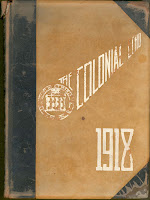The May 8, 1918, edition of the Flat Hat provided a brief summary of the April 19th meeting of the Board of Visitors on its front page including continuing preparations for the arrival of the College of William and Mary's first female students in the fall. Meanwhile, the newspaper's second page (incorrectly dated March 8, 1918) included a plea over two columns entitled "Urged to Stay in College." The presence of the article offers further illustration of William and Mary's precarious enrollment as numbers declined due to the ongoing conflict of war, personal economics, and other reasons.
For additional information about the first women students at the College of William and Mary see: When Mary Entered with her Brother William: Women at the College of William and Mary, 1918-1945 by Laura F. Parrish; "The Petticoat Invasion": Women at the College of William and Mary, 1918-1945; The Martha Barksdale Papers; and the Women at the College of William and Mary page on the Special Collections Research Center Wiki.
May 8, 2008
May 6, 2008
May 1918: The Colonial Echo on Coeds
 As the class of 1918 prepared to graduate from William and Mary, there were some mixed messages from the student body about their feelings of being the last all male class at the College in the yearbook, the Colonial Echo.
As the class of 1918 prepared to graduate from William and Mary, there were some mixed messages from the student body about their feelings of being the last all male class at the College in the yearbook, the Colonial Echo.
At the end of the senior class history on page 36 of the yearbook, the class historian remarked on the “melancholy fact that we are the last class to graduate from this old college before it is defiled by co-education.” While this may imply the historian’s dismay with the College becoming co-educational, twenty-one pages later on page 57 the Colonial Echo “affectionately dedicates this page to the future Co-Eds.”
This yearbook is an excellent example of the conflicting opinions about co-education at William and Mary in the months leading up to the first twenty female students’ arrival in September 1918. As previous entries about Flat Hat opinion articles have shown, there was a small, but vocal, contingent against co-education, which is represented in the yearbook by the historian’s parting line in the class history. At William and Mary, there were also quite a few students and faculty who were either indifferent or supported the arrival of women.
Click to enlarge the senior class history:


For more information on co-education’s reception on campus, as well as other questions, please contact the Special Collections Research Center, Swem Library, College of William and Mary.
This post was composed by Jordan Ecker.
For additional information about the first women students at the College of William and Mary see: When Mary Entered with her Brother William: Women at the College of William and Mary, 1918-1945 by Laura F. Parrish; "The Petticoat Invasion": Women at the College of William and Mary, 1918-1945; The Martha Barksdale Papers; and the Women at the College of William and Mary page on the Special Collections Research Center Wiki.
Subscribe to:
Comments (Atom)


